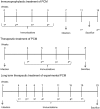Therapeutic DNA vaccine encoding peptide P10 against experimental paracoccidioidomycosis
- PMID: 22389734
- PMCID: PMC3289603
- DOI: 10.1371/journal.pntd.0001519
Therapeutic DNA vaccine encoding peptide P10 against experimental paracoccidioidomycosis
Abstract
Paracoccidioidomycosis (PCM), caused by Paracoccidioides brasiliensis, is the most prevalent invasive fungal disease in South America. Systemic mycoses are the 10th most common cause of death among infectious diseases in Brazil and PCM is responsible for more than 50% of deaths due to fungal infections. PCM is typically treated with sulfonamides, amphotericin B or azoles, although complete eradication of the fungus may not occur and relapsing disease is frequently reported. A 15-mer peptide from the major diagnostic antigen gp43, named P10, can induce a strong T-CD4+ helper-1 immune response in mice. The TEPITOPE algorithm and experimental data have confirmed that most HLA-DR molecules can present P10, which suggests that P10 is a candidate antigen for a PCM vaccine. In the current work, the therapeutic efficacy of plasmid immunization with P10 and/or IL-12 inserts was tested in murine models of PCM. When given prior to or after infection with P. brasiliensis virulent Pb 18 isolate, plasmid-vaccination with P10 and/or IL-12 inserts successfully reduced the fungal burden in lungs of infected mice. In fact, intramuscular administration of a combination of plasmids expressing P10 and IL-12 given weekly for one month, followed by single injections every month for 3 months restored normal lung architecture and eradicated the fungus in mice that were infected one month prior to treatment. The data indicate that immunization with these plasmids is a powerful procedure for prevention and treatment of experimental PCM, with the perspective of being also effective in human patients.
Conflict of interest statement
The authors have declared that no competing interests exist.
Figures





Similar articles
-
Immunization with P10 peptide increases specific immunity and protects immunosuppressed BALB/c mice infected with virulent yeasts of Paracoccidioides brasiliensis.Mycopathologia. 2014 Oct;178(3-4):177-88. doi: 10.1007/s11046-014-9801-1. Epub 2014 Aug 19. Mycopathologia. 2014. PMID: 25135302
-
Paracoccidioides brasiliensis vaccine formulations based on the gp43-derived P10 sequence and the Salmonella enterica FliC flagellin.Infect Immun. 2009 Apr;77(4):1700-7. doi: 10.1128/IAI.01470-08. Epub 2009 Feb 9. Infect Immun. 2009. PMID: 19204092 Free PMC article.
-
PARACOCCIDIOIDOMYCOSIS: CHALLENGES IN THE DEVELOPMENT OF A VACCINE AGAINST AN ENDEMIC MYCOSIS IN THE AMERICAS.Rev Inst Med Trop Sao Paulo. 2015 Sep;57 Suppl 19(Suppl 19):21-4. doi: 10.1590/S0036-46652015000700005. Rev Inst Med Trop Sao Paulo. 2015. PMID: 26465365 Free PMC article. Review.
-
Attempts at a peptide vaccine against paracoccidioidomycosis, adjuvant to chemotherapy.Mycopathologia. 2008 Apr-May;165(4-5):341-52. doi: 10.1007/s11046-007-9056-1. Mycopathologia. 2008. PMID: 18777638 Review.
-
Additive effect of P10 immunization and chemotherapy in anergic mice challenged intratracheally with virulent yeasts of Paracoccidioides brasiliensis.Microbes Infect. 2008 Oct;10(12-13):1251-8. doi: 10.1016/j.micinf.2008.07.027. Epub 2008 Jul 24. Microbes Infect. 2008. PMID: 18694844
Cited by
-
Paracoccidioidomycosis vaccine.Hum Vaccin Immunother. 2012 Oct;8(10):1450-3. doi: 10.4161/hv.21283. Epub 2012 Aug 16. Hum Vaccin Immunother. 2012. PMID: 22894948 Free PMC article. Review.
-
New advances in the development of a vaccine against paracoccidioidomycosis.Front Microbiol. 2012 Jun 12;3:212. doi: 10.3389/fmicb.2012.00212. eCollection 2012. Front Microbiol. 2012. PMID: 22701452 Free PMC article.
-
Inhibition of Paracoccidioides lutzii Pb01 isocitrate lyase by the natural compound argentilactone and its semi-synthetic derivatives.PLoS One. 2014 Apr 21;9(4):e94832. doi: 10.1371/journal.pone.0094832. eCollection 2014. PLoS One. 2014. PMID: 24752170 Free PMC article.
-
Fungal Vaccine Development: State of the Art and Perspectives Using Immunoinformatics.J Fungi (Basel). 2023 May 31;9(6):633. doi: 10.3390/jof9060633. J Fungi (Basel). 2023. PMID: 37367569 Free PMC article. Review.
-
Peptides derived from gp43, the most antigenic protein from Paracoccidioides brasiliensis, form amyloid fibrils in vitro: implications for vaccine development.Sci Rep. 2021 Dec 6;11(1):23440. doi: 10.1038/s41598-021-02898-5. Sci Rep. 2021. PMID: 34873233 Free PMC article.
References
-
- Wanke B, Londero AT. Epidemiology and paracoccidioidomycosis infection. In: Franco M, Lacaz CS, Restrepo A, Del Negro G, editors. Paracoccidioidomycosis. Florida: CRC Press Boca Raton; 1994. pp. 109–117.
-
- Prado M, da Silva MB, Laurenti R, Travassos LR, Taborda CP. Mortality in Brazil of systemic mycosis as primary cause of death or in association with AIDS: a review from 1996 to 2006. Mem Inst Oswaldo Cruz. 2009;104:513–521. - PubMed
-
- Benard G. An overview of the immunopathology of human paracoccidioidomycosis. Mycopathologia. 2008;165:209–221. - PubMed
-
- Shikanai-Yasuda MA, Telles Filho Fde Q, Mendes RP, Colombo AL, Moretti ML. Guidelines in paracoccidioidomycosis. Rev Soc Bras Med Trop. 2006;39:297–310. - PubMed
Publication types
MeSH terms
Substances
LinkOut - more resources
Full Text Sources
Research Materials
Miscellaneous

